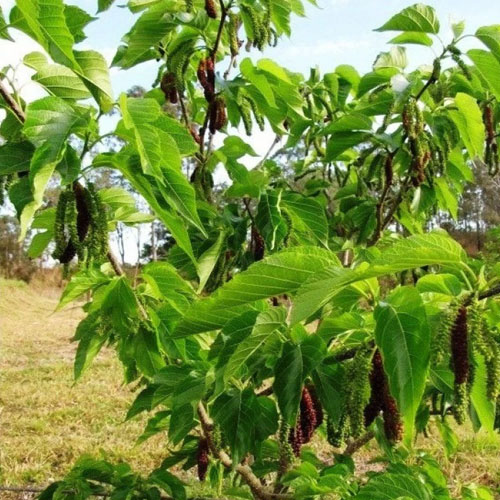Mulberry ( Shahtut) Plants
Mulberry (Shahtut) Plants (Morus species) are deciduous trees or large shrubs known for their fast growth, heart-shaped leaves, and delicious berries. The mulberry plant is commonly grown for its fruit, which is enjoyed fresh, dried, or used in jams and desserts. It also has significant cultural and historical importance, particularly in sericulture (silk production), as mulberry leaves are the primary food source for silkworms. Mulberries are native to temperate regions of Asia, Europe, and North America but are now cultivated worldwide.
Characteristics of Mulberry Plants
-
Size and Growth Habit:
- Mulberry trees can vary significantly in size, ranging from 15 to 70 feet (4.5 to 21 meters) tall, depending on the species and growing conditions.
- They have a spreading canopy with a rounded or vase-like shape and a strong, sturdy trunk.
-
Leaves:
- Mulberry leaves are simple, broad, and heart-shaped with serrated edges. The leaves are typically bright green in the growing season and turn yellow in the fall before dropping.
- Depending on the species, leaves can be lobed or unlobed, and they are arranged alternately along the branches.
-
Flowers:
- Mulberry flowers are small, inconspicuous, and usually green or yellowish. They appear in clusters (catkins) and can be either male or female, or in some species, both types of flowers are present on the same tree.
- The flowers bloom in late spring to early summer, and pollination is primarily by wind, although insects may also contribute.
-
Fruit:
- Mulberry fruit resembles a blackberry and can vary in color from white, red, purple, black, or even pink, depending on the species and variety.
- The fruit is a multiple fruit, meaning it is formed from a cluster of flowers, each contributing a small drupelet. The berries are sweet, juicy, and nutritious, containing vitamins C and K, iron, potassium, and fiber.
-
Lifespan:
- Mulberry trees can live for many decades, with some varieties capable of producing fruit for up to 50 years or more under optimal conditions.
Types of Mulberry Plants
-
White Mulberry (Morus alba):
- Native to China, white mulberry is commonly grown for its leaves, which are used to feed silkworms.
- The fruit can be white, pink, or black and is sweet with a mild flavor. This species is highly adaptable and can grow in various soil types and climates.


